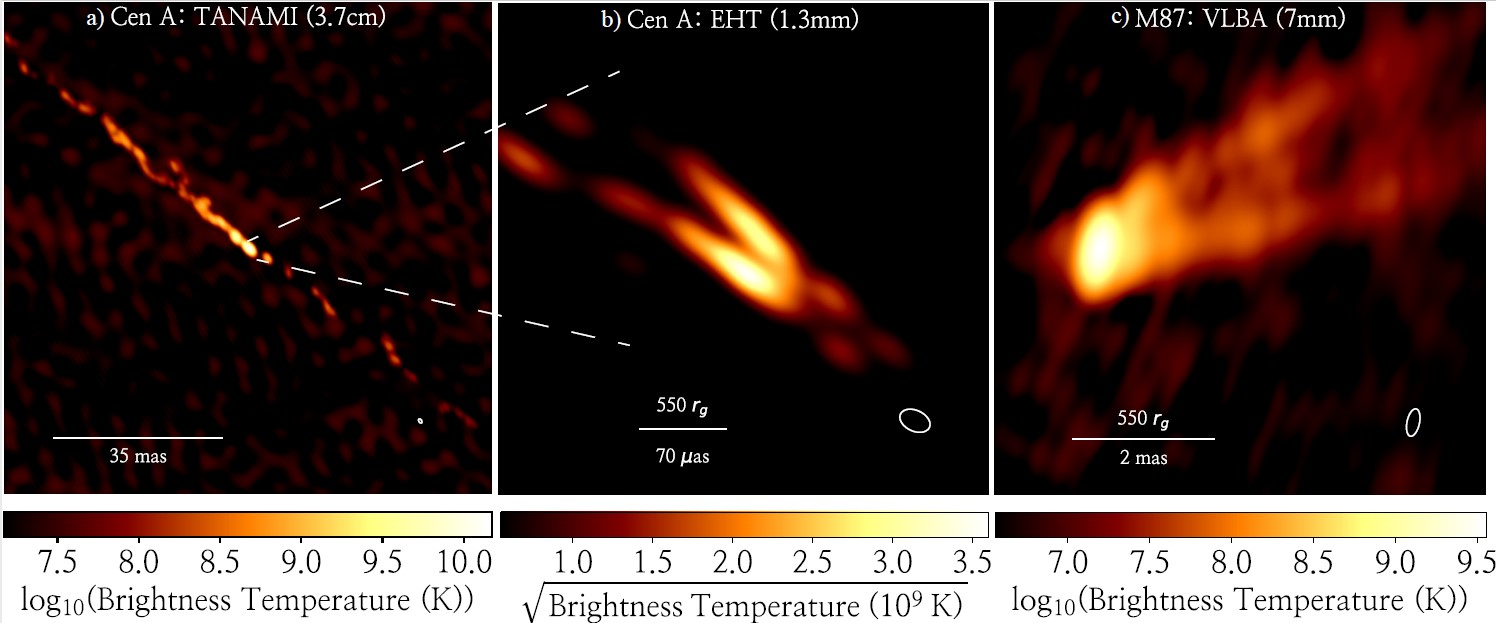The first-ever image of a black hole dazzled people around the world when it was released by the Event Horizon Telescope (EHT) collaboration in 2019. Captured by a radio telescope array that spans the globe, the unprecedented image revealed the eerie shadow around a supermassive black hole at the center of the galaxy Messier 87, located 55 million light years away.
Now, the EHT team has snapped another exceptional picture of a new target: Centaurus A, a galaxy with a supermassive black hole that shoots out energetic jets of matter at near light-speeds, making it an active galactic nucleus (AGN). As the closest AGN to the Milky Way, Centaurus A has been studied extensively by scientists, but never with the extraordinary level of resolution provided by the EHT.
Videos by VICE
The EHT collaboration’s new images capture jet structures on the scale of just 14 light hours, which is only about three times the distance between Earth and Pluto, across an intergalactic expanse of more than 10 million light years, exposing details that challenge current models about jet formation, according to a study published on Monday in Nature Astronomy.
“Centaurus A is a very famous galaxy in the overall astronomical community,” said Michael Janssen, a researcher at Max Planck Institute for Radio Astronomy who led the new study, in an email.
“However, the highest resolution observations that we have of this source resolve the jet on ‘only’ light-year length scales,” he added. “With the EHT, we have a unique instrument that can make a tremendous jump in resolution compared to all previous observations, which allows us to see what this jet really looks like up-close on sub-light-day length scales immediately after it has been launched by the black hole.”

Unlike the famous EHT image of Messier 87, which traces the outline of a supermassive black hole, the new snapshot zooms in on the base of one Centaurus A’s jets as it accelerates across the galaxy. The jet is created by gassy material that accretes around the galaxy’s supermassive black hole, which gets blasted out as a stream of ionized matter by the black hole’s intense tidal and magnetic forces.
“The EHT has probed a completely new region of the jet in Centaurus A, with a 16x sharper resolution and 10x higher observing frequency compared to previous high-resolution studies of this source,” said Janssen. “We suspected the jet to look like a knotty collimated structure seen in earlier [centimeter Very-long-baseline interferometry] observations, but we were also ready to see something new and exciting with this unprecedented resolution.”
Previous images of Centaurus A’s jet were not able to resolve the variation in the brightness of the jet, a property that contains clues about the forces that are fueling it. But the EHT image, which was captured over six hours on April 10, 2017, shows that the jet is so bright that Janssen said his team was “astonished when we finally saw the image” and “performed many validation checks to ensure that we can trust what we are seeing.”
“With the EHT, we resolve sub-light-day scales of this source and see that the jet is actually strongly edge-brightened,” Janssen explained. “This is challenging our theoretical models, which do not produce this effect as pronounced as we see it in Centaurus A naturally.”
“We think that this hints at a very strong helical magnetic field that is being produced by a spinning central black hole,” he continued. “Alternatively, the jet might be rotating very fast around its own central axis or the jet might consist only of a very thin radiating sheath (like a thin hollow cylinder).”
While the study revealed unexpected challenges to some models, it also bolstered a longstanding theory known as “the fundamental plane of black hole activity.” This idea sketches out a basic relationship between the accreting matter that flows into a black hole and the matter that gets shot out in jets, and predicts that this equation should hold for black holes of any size.
The theory has been successfully tested in black holes that are just a few times more massive than the Sun, all the way up to objects that are billions of times more massive than the Sun, such as the supermassive black hole at the center of Messier 87.
Now, Janssen and his colleagues have demonstrated that the relationship is also present in black holes that are millions of times more massive than the Sun, like the one at the center of Centaurus A. The results imply that jets from supermassive black holes behave like scaled-up versions of their stellar counterparts, which complies with the framework of Einstein’s theory of general relativity.
This new close-up view of the jet, and its black hole environment, can shed light on a host of other intriguing scientific questions. For instance, these jets are widely thought to be a major source of ultra-high-energy cosmic rays, which are the most energetic particles that reach Earth and contain information about the high-energy universe. Scientists also want to understand how the immensely powerful jets of active nuclei influence the evolution of their host galaxies.
To that end, Janssen and his colleagues plan to continue studying Centaurus A’s jet, including with another intercontinental telescope network, the Global mm-VLBI Array (GMVA VLBI), to unravel more of its secrets. The proximity of this AGN to the Milky Way, combined with the perplexing properties of its jet, might help to resolve some of the many open questions about these radiant and pyrotechnic galaxies.
“The next step will be to image the jet in polarized light, to infer the structure of the magnetic fields in the jet,” Janssen said. “This will tell us more about the nature of the edge-brightening and also help us with a more constrained theoretical modeling of the jet.”
More
From VICE
-

Digimon Story: Time Stranger -

(Photo by Dana Jacobs/WireImage) -

Netflix -

Monica Schipper/WireImage
